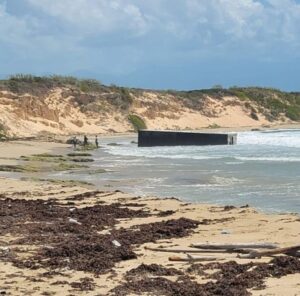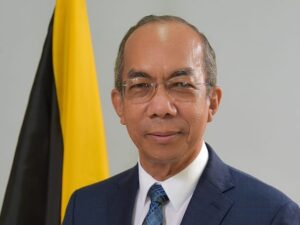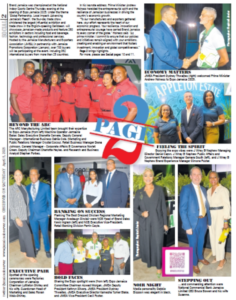Boundaries bill blur election signs
A bill tabled in the House of Representatives on Wednesday seeking to constitutionally increase the maximum number of constituencies from 60 to 65 will likely stymie any plan for an early general election, with sources saying the process will take more than a year.
The bill would create a maximum limit of 65 seats, but would initially approve 63, giving the Electoral Advisory Committee (EAC) two seats to play with in case of other constituencies exceeding the limit of 34,000 electors.
The odd number seats were agreed to avoid the posibility of an equal distribution of seats in the House and the fight for governing control that would ensue.
The EAC, which comprises politicians from the two main political parties, put forward the proposal a year after the October 2002 general election, spooked by the close finish in the poll and a tie in Trinidad and Tobago, but had given no convincing argument for going higher with the seat count instead of lower.
Government and opposition sources involved in the process tell the Sunday Observer that the expansion of the maximum limit would delay a general election by another 15 months.
This is primarily due to time needed to complete the process, plus a still unconfirmed “understanding” that there is a six-month no election period prior to and after the staging of next year’s ICC Cricket World Cup (CWC) competition in the Caribbean.
The bill, tabled by Leader of the House and Minister of National Security Dr Peter Phillips, has become necessary because the current maximum constitutional limit of 60 seats is creating difficulties for the EAC in ensuring that some constituencies remain within the constitutional limit of a maximum 34,000 electors.
The limit is worked out on the basis of two thirds of the average number of electors in all constituencies as the minimum, and 150 per cent of the average as the maximum.
Some constituencies in St Catherine and St James have had their boundaries changed since 2004 on the recommendation of the EAC.
The fast growing constituencies of South St Catherine, represented by the People’s National Party’s (PNP) Fitz Jackson, and North West St James, represented by the JLP’s Dr Horace Chang, had exceeded the maximum and were in breach of the constitution.
In 2004, the boundaries committee of the House of Representatives agreed on changes which have affected a number of constituencies in St Catherine, including Central, East Central, South Central, South East, South West, West Central and South.
There have been a number of interchanging of polling divisions (PDs) between the St Catherine constituencies, including:
. the switching of two PDs in Naggo Head from South to South East, represented by Dr Paul Robertson;
. the movement of Windsor or ‘Sufferers’ Heights and sections of Central Village from South Central, represented by the PNP’s Sharon Hay-Webster, to other constituencies, including KD Knight’s East Central; and
. the removal of all of Willowdene and most of Crescent from the JLP controlled Central seat held by Olivia ‘Babsy’ Grange, to East Central, with South Central now extended to the March Pen area and Central now stretching as far as Featherbed Lane.
Observers suggest that the changes have weakened Hay Webster and Robertson, but could strengthen Knight and Jackson, while Grange’s support is expected to remain stable.
This could result in the loss of one or two seats in the parish to the JLP.
In St James, while the JLP’s Clive Mullings in West Central seems to have had his majority affected by the changes, the JLP’s Dr Horace Chang in North West and Edmund Bartlett in East Central seem to have benefited from the changes.
These changes will remain intact until the House resolves the issue of where to locate or, more precisely, the boundaries of the additional three seats, two of which are likely to be in St Catherine and one in St James.
The JLP is convinced that the addition of the three seats will ensure them an increase of seats in both parishes.
When the issue first came up in the House of Representatives in February 2004, JLP members of the EAC threatened to resign from the committee if the government stalled on the proposed changes.
The threat was followed by howls of disagreement from government members, notably by Phillips and Robertson.
Phillips suggested that there might even have been some “gerrymandering” of the proposed boundary changes.
And Robertson claimed that some of basic rules adopted by the EAC, when he was a member, were not observed, including, he said, the need to follow natural boundary lines and to keep communities together.
But the Opposition were adamant that the House should stick to the custom of adopting proposals from the EAC without amendments.
“If they do not accept the recommendations in our report in time, then the committee will no longer have any relevance. We may be forced to resign,” former JLP member Ryan Peralto threatened then.
Peralto was referring to the missed the deadline of boundary changes by March 2004, which meant that no further changes could be made within four years.
The constitution requires that boundaries can be made at least four years apart, but no more than six years apart.
Peralto was supported by a letter from EAC chairman Professor Errol Miller to Parliament then, who pointed out that the recommendations from the EAC to delineate the boundaries “were designed to strengthen and advance our democracy and to avoid problems in the electoral system which can be clearly foreseen.”
“It is, therefore, critical that these recommendations be implemented as a matter of priority,” Miller said.
In mid-March of 2004, the House of Representatives approved the decision to increase the seats to a maximum 65 and endorsed the decision to make the boundaries changes in the meantime.
balfordh@jamaicaobserver.com












